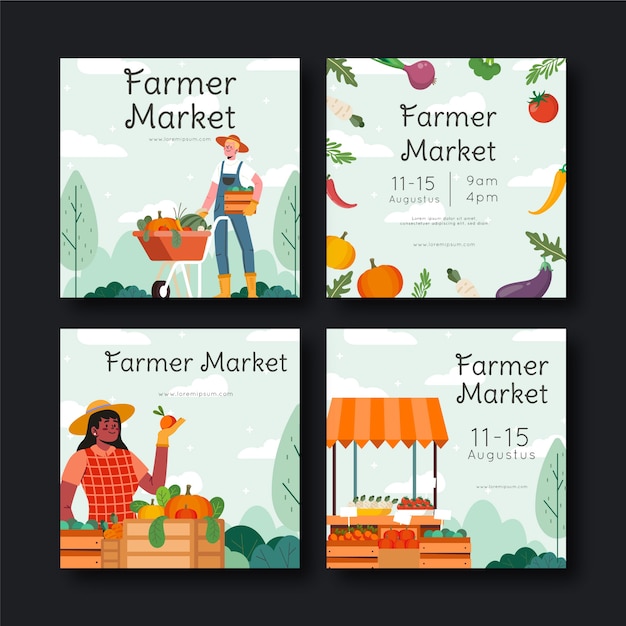So, you’re a fan of your local farmers’ market, right? You enjoy supporting local farmers and artisans, but have you ever thought about becoming a vendor yourself? You don’t need to own a farm or milk cows every day to do this. All you need is a reliable source of fresh produce, animal products, or handmade goods.
You could have a small vegetable garden, a few livestock, or a knack for making food or non-food products. In theory, you could run a stall at the farmers’ market. Of course, the reality is a bit more complex, but it’s definitely doable if you’re committed.
This guide will cover the types of vendors that usually sell at farmers’ markets, how to get started, and some tips to improve your experience and earnings. But before you start, you might want to consider getting a small business insurance policy for liability and property protection.
Now, let’s see if you’re a good fit for a farmers’ market. You don’t need to own farmland to fit in. A well-maintained backyard garden or livestock operation, or a legal foraging business, could be enough to sustain a small stall throughout the season.
If you make value-added products, like preserved fruits and vegetables, prepared foods, or non-food crafts, you’re in an even better position. Every farmers’ market is different, but these product categories are generally accepted by U.S. markets and are relatively easy for small-scale sellers to procure.
Fresh fruits and vegetables are always a hit. The possibilities are endless, depending on your local growing conditions. Popular vegetables include cooking greens, salad greens, radishes, carrots, summer squash, cruciferous vegetables, chives, and more. Popular fruits include blueberries, raspberries, blackberries, strawberries, apples, pears, peaches, melons, peppers, tomatoes, and rhubarb.
Raising small livestock like chickens, rabbits, or even bees is easier than you might think. Chicken eggs are a popular product, and even a modest beekeeping operation can produce a few jars of honey to supplement your income.
Preserving fruits and vegetables is easier than you might think. You can also sell durable produce that lasts for weeks or even months, like potatoes, gourds, turnips, rutabaga, and other root vegetables.
Homemade food products are another great option. Licensing requirements vary, but you can probably sell reasonable quantities of homemade value-added food products without getting bogged down in red tape.
Prepared foods are also a good option, assuming you meet the licensing and inspection requirements. This category covers food products that your customers will consume at the market or shortly after leaving.
If you’re more comfortable at the workbench than in the kitchen or garden, you can sell non-edible items. While some markets are strictly food-only, most allow non-food vendors or vendors that sell a mix of edible and non-edible items.
Now, let’s go through a step-by-step guide to getting started at the farmers’ market.
First, figure out what you’ll sell at your stall. This depends on your personal interests, what’s practical for you to grow or prepare given your resources, market policies and restrictions, and local ordinances.
Next, plan your stall and make a startup budget. You’ll need to consider the stall fee, tables and seating, weather protection, personnel, cold storage, hot storage, cash storage, carryout bags, credit card processing, and printed collateral.
Then, confirm that you meet your target market’s vendor criteria. Some markets strictly prohibit resellers or value-added product vendors, for instance.
Before you sell a single item at the farmers’ market, you’ll need to get right with the law. Find out what’s required in your area, complete any required applications, get a food safety certification if required, get an insurance policy, and consider incorporating your business.
Next, secure your spot at a market. Popular farmers’ markets often have waiting lists, so don’t be surprised if you don’t get your first choice your first year in business.
Determine how you’ll get your wares to the market each week. Depending on the nature of your enterprise, you’ll need suitable packaging, reliable transportation, and approved production facilities.
Lastly, make sure your stall is eye-catching. Check with market management for guidance on approved dimensions, colors, materials, and any other notable restrictions.
Here are some tips and tricks to get more out of your farmers’ market stall: understand the market’s clientele and vendors, understand the market’s regulations, promote your stall through multiple channels, don’t misrepresent yourself or your products, differentiate your selection, consider value-added products, be prepared for health inspections, start with a limited inventory and build from there, stay on top of licensing and insurance requirements, stay in your neighbors’ good graces, advertise other sales channels at your stall, and have a year-round plan.
Running a stall at a farmers’ market can be a fun hobby that brings in a little extra income. But if you’re ambitious and talented, your local farmers’ market could be your ticket to a profitable side business or even a full-time enterprise. It’s not easy, but it’s definitely doable. Good luck!
